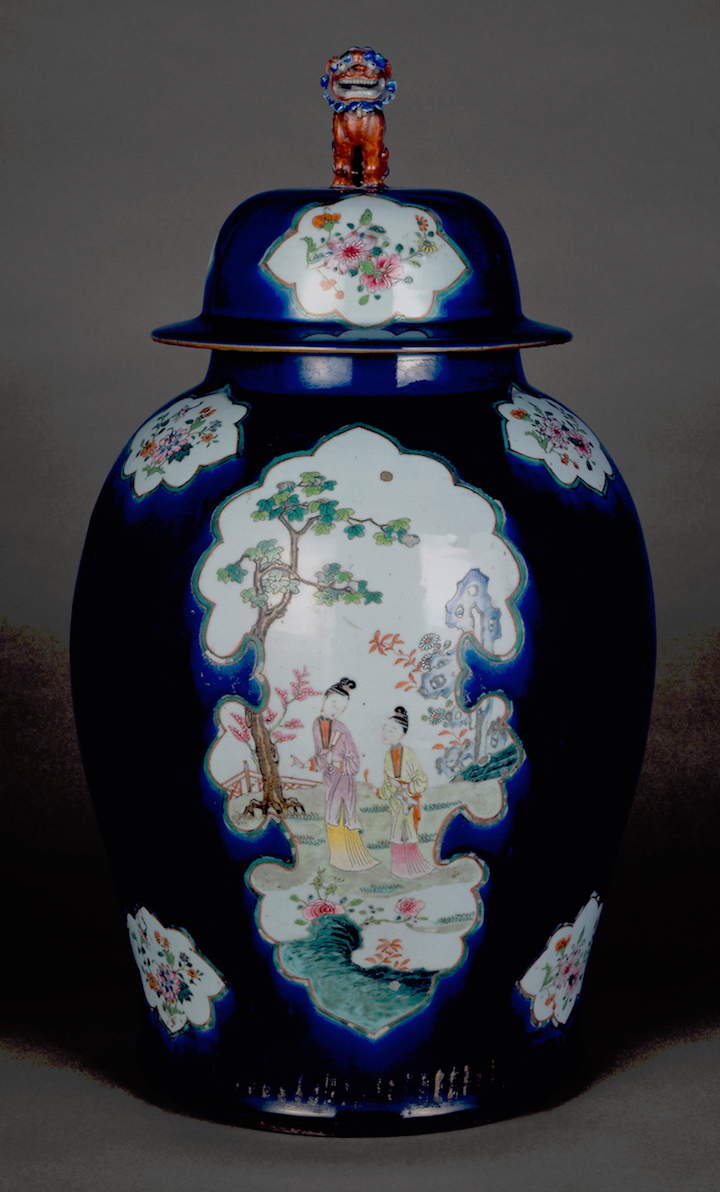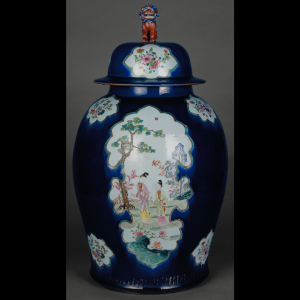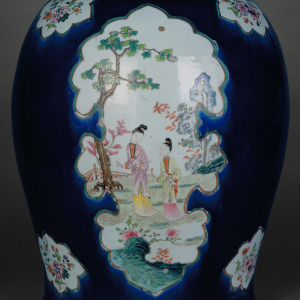Pot
Author: Unknown
Origin: Jingdezhen Kilns, China
Dating: c.1740 (Qing Dynasty, Qianlong period)
Material: Porcelain
Dimensions (cm): 63,2 x Ø 37,3
Inv. no.: PD0300
A pot made of porcelain coated with “blown blue” over the glaze. The blue background is decorated in gold with a “cracked ice” pattern and plum blossom corollas.
On the body, three large reserves stand out in the shape of a cut-out and polylobed leaf, outlined in green and iron red, painted naturalistically with soft famille-rose enamels. There are three figurative landscapes, alluding to the theme of longevity.
The reserves are separated by six smaller ones, painted with multicolored peony flower branches. The lid is decorated with three small reserves filled with butterflies fluttering between peony flower branches, similar to those on the pot.
Its decoration features female characters, a recurring representation in the Yongzheng period. Daily life experiences – indoors or outdoors – often carry a symbolic message of religious connection or are simply copied from illustrations of popular stories at the time.
In this particular case, the theme of longevity is expressed through the constant presence of the sacred mushroom of immortality, the deer (the only animal capable of finding it), the lotus flower – which, besides being a symbol of purity, is also one of the attributes of the young He Xiangu. From the sacred set of the Immortals – along with the heron or crane, pines, plum trees and rocks – all symbolize longevity and durability. The buffalo painted in one of the scenes, according to the Taoist and Buddhist religions, reinforces the idea of strength, allied to prosperity and the ideal tranquillity of life.
“Music in the Palace’s Collections”
In this object, one of the women appears to have «a fan and the other holds a guitar-shaped instrument in her left hand. The right hand has an object that, in context, may be interpreted as a plectrum which today would be called a “pick”, meaning: a small blade of a hard material (bone, ivory or plastic) with which the strings are made to vibrate.
Having been produced in the 18th century, the configuration of the guitar does not conform to any standard of the instruments used at the time. The Chinese musical instrument most similar to Western string instruments is the Pipa, a pear-shaped instrument, similar to a lute. Since, in this period, the Chinese porcelain industry was manufacturing especially for exportation, it is known that decorators used images from the West. The shape of the guitar is somewhat reminiscent of the medieval Latin guitars similar to those that appear in the Cantigas de Santa Maria. Within the decorative theme of the pot – everyday life scenes – the musical image emphasizes the importance of music in that same everyday life.»
Eduardo Magalhães





